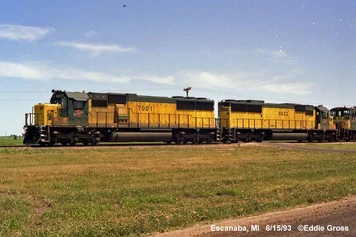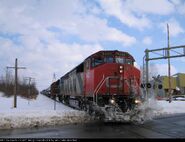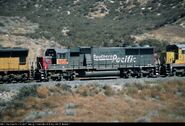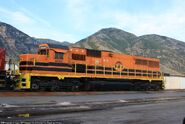Bio[]
The EMD (Electro Motive Division) SD50 is a type of 3,500hp (or 3,600hp in some cases) six-axle diesel
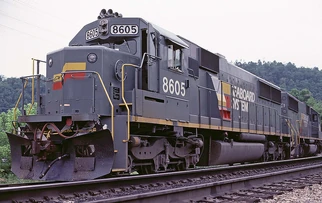
Brand-new Seaboard System (later CSX) SD50 units awaiting their next assignment. CSX now primarily employs their SD50's for use as helpers, or for local service. Most have since been rebuilt and reclassed as an "SD50-2" or an "SD50-3", however.
locomotive built from 1980 to 1986, but didn't officially begin production until 1984 after receiving full order placements in 1983.
487 were built for a handful of Class 1 railroads, most notably CSX, DRGW (Denver And Rio Grande Western), Conrail (CR), CN (Canadian National), CNW (Chicago And North Western), Norfolk Southern (NS), Kansas City Southern (KCS) and Missouri Pacific (MP; Mopac). 5 were also built for Hamersley Iron for use in the Pilbara region in Australia, totalling 492 units.
Several were built into what are dubbed as an "SDL50" for use in Saudi Arabia for the Saudi Railways Organization, which include large filter boxes mounted above the dynamic brake grid section for filtering sand, dirt, and dust from harsh desert conditions. Said units were built between 2003-2004.
Many have since been retired, rebuild, scrapped, downgraded, upgraded, or de-rated to having just 3,000hp or 3,200hp. Said units are classified as an "SD40E" by NS, or as a "SD50-2" or "SD50-3" due to being upgraded to "Dash 2" or "Dash 3" specs by CSX. Said units are essentially new-era SD40-2's.
Only a handful of true, non-modified units remain in service with various shortlines and/or leasing companies. Others are currently stored at facilities like NRE (National Rail Equipment) in Silvis, IL. CSX and NS are currently the only Class 1 railroads to utilize them for general service, but are typically assigned in helper or local service alongside SD40-2's. Several are still currently in their original state; not receiving any modifications, on both railroads as well.
NS and CSX are the only Class 1 railroad which currently utilize them for service. They have since been retired or withdrawn from CN, KCS, and UP.
History[]
The EMD SD50 was originally designed to be a successor to the SD40-2. A brand-new entry to the existing 645-engined line, it introduced what was otherwise an "enhanced" variant or version of the 16-645E3, but with an additional 500 to 600hp rating as a result of having a more

CSX #8619: the sole SD50-3 unit.
advanced turbocharger and alternator (AR11 as opposed to the usual AR10 model equipped on the SD40-2; originally AR16) known as the "645F" or 16-645F. The horsepower rating was also increased through the latest D87 traction motors rather than being equipped with the more common D77 model present on preceding models. Although the updated turbocharger, alternator, and other internal components and equipment proved to be effective, they increased the overall length or displacement of the entire prime-mover. To accommodate said changes, EMD constructed a longer carbody to house it, therefore giving the locomotive model its distinct, broad appearance as opposed to having a smaller carbody on a longer frame like its predecessor. Apart from said changes came a more effective one: the relocation of the dynamic brake grid. Gone was the distinct "blister" or "center radiator" found on most domestic six-axle models beginning with the SD7/SD9 (excluding four-axle ones), in its place was a large box which was more uniform to the overall shape and styling of the carbody. The relocation of the dynamic braking grid was a decision ultimately made upon the request of loyal customers, for the effectiveness of dynamic braking was more efficient located at the front rather than the center, for the heat of the prime-mover ultimately caused severe problems affecting the performance and reponse times later-on in the locomotive's lifespan (and in-general), while also increasing maintenance costs on said preceding models. The SD50's dynamic braking grid, however, rectified said problems. Though, later-on in development, the locomotive builder refined the carbody by adding at least 3 feet to give it more of a streamlined performance.
During development, EMD began to implement new features that weren't originally offered on the preceding model to help broaden their marketing towards customers and to further evolve towards a new era of technology for motive power by introducing revolutionary microprocessor controls. Said features included were state-of-the-art Doppler-controlled "Super Series" wheel-slip system which used a locomotive-mounted doppler radar gun to measure track speed which was then displayed on a digital speedometer. Additional features included cab signalling, though only some railroads (notably Conrail) chose to install said feature on most of their units. Although high-tech at the time, the latter features were somewhat ahead of its time with some railroads that were more traditional as opposed to seeking new technology, as well as the model having been deemed to be too costly to maintain as a result of its two-stroke engine versus the otherwise "efficient" four-stroke 7FDL engine line from GE at the time of production. Furthermore, the recession during the early 1980's affected most railroads, for they had the vast majority of their fleets in storage; meaning that traffic was low, and little to almost no profit was to be made during the time. Therefore, sales were low upon the debut of the new locomotive model, but railroads still insisted on placing orders over the course of a three and a-half year span totaling an amount of 427 units. Despite being incredibly low compared to the vast amount of SD40-2's built, EMD still offered numerous discounts for large orders (notably with Conrail; considering that they ordered a total of 125 units) to keep up with the competition against their long-term rival while staying afloat with profits.
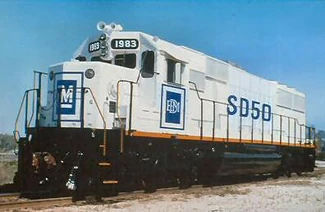
EMDX 1983: one of the first SD50's officially built.
Like previous experiments with the four SD40X units delivered to KCS in 1979, EMD originally built 6 prototype units dubbed "SD50S" ("S" for "shorter frame") for the N&W (Norfolk And Western) prior to the 1982 merger with the SOU (Southern Railroad) forming Norfolk Southern. Said units were merely a small stepping stone for the subsequent SD50 model, for the final product was still undergoing development at EMD's LaGrange, IL facility. But once the first orders from CSX and MP (UP) began placement, trouble struck during production. Although it initially was successful: being one of the very first North American diesel locomotives to implement modern digital microprocessor controls (besides its four-axle counter-part: the GP50 as well as GE's C40-8 and preceding models) and greatly improved tractive effort, load ratings, and had a higher horsepower rating than the preceding SD40-2; it actually created more problems than what it originally solved. The most well-known issues included having faulty wiring and electronics, besides the fact that the engine or prime-mover was literally "over-stressed"; meaning that it ran at a higher rpm rate that the engine could handle (950 rpm as opposed to just 900 rpm for the larger, more powerful 710G engine utilized on its successor: the SD60) which furthermore resulted in numerous engine failures. Also, during testing at EMD's LaGrange facility (prior to delivery), each of the SD50 units assembled were reported with at least 25 defects per unit upon completion. Therefore, because of said drawbacks, most of the earlier units built had their deliveries post-poned until further troubleshooting was made.
Despite not having proved to be popular due to its rough debut, the SD50 became an instant success once improvements were made, and it proved to be generally popular with eastern-based US Class 1 railroads like CSX, CR, and NS for heavy-haul applications. Canadian-based CN on the other-hand, had their own cowl-bodied variant known as the "SD50F" for use in cold weather environments, and were built with a "Draper taper" (inset section aft of cab for limited rear visibility; named after CN Assistant Chief of Motive Power William L. Draper). And like today's modern, specialty export (or domestically-modified) locomotives in-use today throughout most of Australia, 5 domestic SD50 units were assembled by Clyde Engineering (a long-time affiliate of EMD), and were built with a specialized cooling system used for operation in hot desert conditions throughout the Australian Outback, and consisted of a shorter frame reminiscent of the earlier testbeds sold to Norfolk Southern. The units were also designated with an "S" due to the shorter frame, besides being a specialty model. A similar occurrence was also present with the "SDL50": a specialty variant built for use in the harsh desert environments of Saudi Arabia.
Because of how drastically out-sold it was compared to GE's later Dash 7 models (like the C30-7 and C36-7) and subsequent early Dash 8 ones (like the C39-8), the SD50 has since been regarded as the model that dropped EMD's dominant presence over GE as the leading or "number 1" locomotive builder; but at the same time, was also a transitional model. Though, the succeeding SD60 began a new era for the company prior to the discontinuation of the SD50, and further rebounded the company's sales and reputation; despite having less than five years of production like its subsequent four-axle counter-part.
Confusion[]
Many railfans and/or train enthusiasts often confuse the SD50 for a standard, original (non-modified) SD60. There are numerous ways to avoid confusion between the latter:
- The owners for both models vary, despite CSX and NS having active fleets of said diesels (many which are former Conrail units). The main way to distinguish the latter is by the number series, or the equipment mounted on the roof of the cab (as-seen on CSX's SD50-2's); apart from the amount of hood doors or engine access panels.
- Most earlier units have a much shorter front hood or "nose" unlike most SD60 units.

A CNW SD50 when compared to a CNW SD60.
- The only other notable external difference is the presence of 8 hood door panels (or access panels) under the radiator grids on the SD60 versus 6 door panels on the SD50.
- Although not an external difference, the SD60 has a more distinct "roar" or "hum" from its 710 engine; reminiscent of a jet engine (as recalled by most railfans). The SD50; however, sounds almost exactly like an SD40-2 (being a 645 model).
- Most SD60 units (most notably ex-SOO and Oakway) include a distinct radiator fan weather cover located on the fan facing the front of the carbody. Prior to the UP-CNW merger, however, the CNW's fleet of SD50 units weren't equipped with said fan covers unlike their SD60 relatives. Said SD60 units had their covers removed following the merger, further making them nearly identical in comparison.
- Most SD60 units have noticeably larger radiator fans.
- CNW's SD50's are numbered 7000-7034, while their SD60's are numbered 8001-8055.
- CN's SD50F's are numbered 5400-5459, while their SD60F's are numbered 5500-5563.
- Conrail's SD50's were numbered 6700-6834, while their SD60's were numbered 6843-6867 (minus their subsequent SD60I fleet).
Specifications[]
| Model | SD40X* | SD50S* | SD50 | SD50F | SD50S (2)* |
|---|---|---|---|---|---|
| Production Dates | 1979 | 1980 | 1984-1985 | 1985-1987 | 1982 |
| Total Built | 4 | 6 | 421 | 60 | 5 |
| Length | 68' 10" | 68' 10" | 71' 2" | 71' 2" | N/A |
| Wheel Arrangemtnt | C-C | C-C | C-C | C-C | C-C |
| Engine | 16-645F3 | 16-645F3 | 16-645F3/F3B | 16-645F3B | 16-645F3/F3B |
| Horsepower | 3,500 | 3,500 | 3,500 (3,600) | 3,500 (3,600) | 3,500 (3,600) |
| Alternator | AR16 | AR16 |
AR16/D18 (3,500hp) AR11 (3,600hp) |
AR11 | N/A |
| Traction Motors | D87Y | D87 |
D87Y (3,500) D87A (3,600) |
D87 | N/A |
| Weight x 1,000lbs. | 387-393 | 390 | 368 | 390 | N/A |
Note*: This is the second use for the SD40X designation. The original nine SD40 prototype units built in 1964-1965 were also given an SD40X model designation, while also retaining an "SD35X" one.
Note*: First 6 production SD50 units were built exclusively for the N&W on shorter frames.
Note*: Second batch of SD50S units built for Hamersley Iron were built by EMD licensee Clyde Engineering of Australia in 1982.
Trivia/Facts[]
The SD50 was originally meant to mark the launch of a new "50 Series" line, though the plan fell-through in spite of efforts from EMD's endorsements of the model.
Union Pacific has since retired all of their ex-SP (nee DRGW), CNW, and ex-MP SD50's in which they inherited in favor of utilizing their SD70M's. Such units can now be found in service on various shortlines and/or leasing companies, while others are simply in storage or are sitting in scrap yards awaiting their demise; despite some being less than 30 years old when compared to an SD40 or SD40-2.
The Australian SD50S units were withdrawn or retired from service and were sold to NRE (National Rail Equipment) after being exported back to the US in 1995. They were eventually leased to NS in 1999, and were finally sold to the Utah Railway in 2001 where they have remained ever since.
During the time of the CSX merger, the railroad utilized their earlier fleets of units acquired by Chessie System and Seaboard System SD50 units prior to the finalization of the merger as rear-end helpers in the Allegheny mountain range throughout routes such as the railroad's Keystone Subdivision; where steep-graded coal drags or coal trains required additional assistance up-grade and were often lead or hauled by various four-axle diesels at the time, which tended to severely strain the SD50's tractive effort performance due to its otherwise out of balance gear ratio while on the rear of the train. This was all before the SD60's introduction, which greatly improved on everything that the SD50 suffered.
Remarkably, two original SD50S units still exist, but have since been rebuilt into SD40E's by NS.
The SD50's ordered by CSX (both before, during, and after the merger) were equipped with Nathan K5LA airhorns, and were some of the first units throughout the entire company's roster to include such horn model which has been greatly used on every other locomotive model owned except for their GE Gensets, GEVO's, and SD70ACe's (although their SD70ACe's use a 1L bell variant known as the K5LLA).
During 1984, two SBD SD50's (SBD 8525 and 8526) were used as microprocessor demonstrator units used for testing purposes. They originally wore basic primer grey liveries before eventually receiving their full "Seaboard" decals and respective numbers (despite having been renumbered a year later upon the CSX merger).
As a result of the SP-DRGW merger in 1988-1989, an agreement was made between the railroads that the share-holder (SP) was ultimately responsible for locomotive management. In other-words, many locomotives ordered under the DRGW were to be painted in SP paint, while existing DRGW-owned units in-need of a fresh coat were simply repainted in the "Speed Lettering" variant of the SP's "Bloody Nose" scheme; albeit retaining their original respective numbers, but with the "DRGW" reporting mark stenciled underneath the sides of the cab. Such example can be seen on their SD50's.
Most of the DRGW's SD50 units were delivered and built to CSX specs, and featured a K5LA airhorn, "mail slot" battery boxes, and hood-mounted bells.
The first batch of SD50 units delivered to Conrail were built with the earlier "Flexicoil" six-axle truck design found on all domestic six-axle models built by EMD prior to 1972. Conrail requested said truck model from EMD for the railroad was somewhat paranoid over the Amtrak SDP40F derailment conspiracy, meaning that the "Dash 2" era "HTC" (or HT-C) truck was often to blame for the frequent derailments caused by the SDP40F units used by Amtrak in their early years. Though, it was eventually proven false, for the weight of the water stored for the on-board steam generators on tight curves was the true culprit.
Gallery[]
Sources[]
http://www.thedieselshop.us/Data%20EMD%20SD50.HTML
Modern Locomotives: High Horsepower Diesels: 1966-2000 (ISBN-13: 978-0-7578-2681-1/ISBN-10: 0-7858-2681-5)
http://www.rrpicturearchives.net/locoList.aspx?mid=1019

